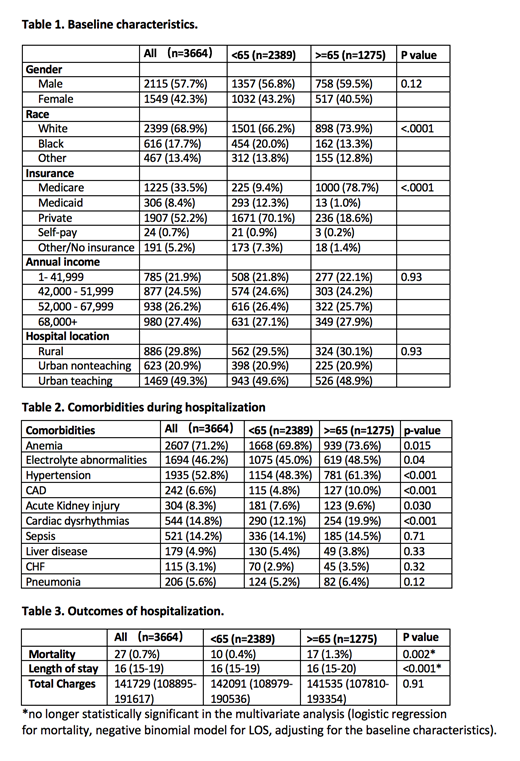Background. Use of Autologous Stem Cell Transplantation (ASCT) continues to increase in elderly patients with multiple myeloma. The main goal of our study was to describe in-hospital complications and outcomes after ASCT in patients younger and older than 65-years old utilizing the Nationwide Inpatient Sample (NIS) database.
Methods. Cohort selection. The NIS database for the years 2011 to 2015 was queried for the analysis. We used International Classification of Diseases, Ninth Revision, Clinical Modification (ICD-9-CM) in order to identify patients with MM as a primary diagnosis for the hospitalization, and ASCT as a primary diagnosis of the hospitalization. In order to determine comorbidities in selected population we used Clinical Classifications Software (CCS) in conjunction with ICD-9-CM codes. Statistical Analysis.Complex weights were used throughout all calculations, enabling appropriate national projections. Chi-squared and independent t-tests were used for univariate analysis where appropriate. In our study p-value <0.05 was considered statistically significant. Data were analyzed using SAS v9.4 (SAS Institute, Cary, NC).
Results.A total of 3,664 patients with MM receiving ASCT were identified in our cohort. Males represented 57.1% of the population, majority of the patients were white, with private insurance, located at the urban teaching hospitals (Table 1). Main insurance in patients older than 65 years old was Medicare. Main comorbidities during hospitalization were anemia, hypertension, electrolyte abnormalities, acute kidney injury, cardiac dysrhythmias, sepsis and pneumonia (Table 2). Overall in-hospital mortality was low, 0.7%, and was significantly higher in patients older than 65 years old (1.3% vs 0.4%, p-value 0.002), however when adjusted for the baseline characteristics with multivariate logistic regression analysis in-hospital mortality was no longer statistically significant (Table 3).
Conclusions. We found that patients older than 65 years with MM receiving ASCT are more susceptible to in-hospital complications. However we found that in-hospital outcomes are not statistically significant when adjusted to baseline characteristics, suggesting that the procedure is safe even in the elderly population. Findings of our study can be used to design future randomized controlled trials.
No relevant conflicts of interest to declare.
Author notes
Asterisk with author names denotes non-ASH members.


This feature is available to Subscribers Only
Sign In or Create an Account Close Modal